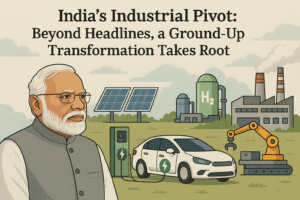India’s Industrial Pivot: Beyond Headlines, a Ground-Up Transformation Takes Root
India is strategically restructuring its industrial foundation around electric mobility (EV), green technology manufacturing, and self-reliance. Beyond subsidies, initiatives like the PLI scheme target critical gaps—luring battery production to cut import reliance and building domestic EV component clusters. Green tech efforts prioritize manufacturing solar cells and hydrogen systems, not just deployment, to break supply chain dependencies.
Self-reliance is driven by selective PLI investments in high-impact sectors and integrating MSMEs into modern supply chains. Public-private partnerships accelerate practical execution—charging infrastructure, green hydrogen pilots, and R&D. This transformation aims to create skilled jobs, enhance export potential, and secure trade while aligning growth with sustainability. Success hinges on scaling component ecosystems and critical mineral access, but the integrated strategy marks a decisive shift toward competitive, resilient industries.

India’s Industrial Pivot: Beyond Headlines, a Ground-Up Transformation Takes Root
Prime Minister Narendra Modi’s recent spotlight on India’s industrial transformation isn’t just political messaging – it signals a tangible, multi-pronged shift reshaping the nation’s economic bedrock. Moving beyond generic “green growth” aspirations, India is executing a coordinated strategy focused on electric mobility (EV), green technology, and self-reliant manufacturing (Atmanirbhar Bharat). Here’s the substance behind the headlines and why it matters:
- Electric Mobility: Charging Beyond Subsidies * Supply Chain Focus: Initiatives like the Production Linked Incentive (PLI) Scheme for Advanced Chemistry Cell (ACC) Battery Storage target the EV ecosystem’s core weakness – battery dependency. This aims to lure global players and foster domestic cell manufacturing, reducing import costs significantly. * Demand & Infrastructure Push: Schemes like FAME III (anticipated) are expected to evolve beyond vehicle subsidies towards bolstering charging infrastructure – critical for mass adoption, especially for commercial fleets and long-range travel. Public-private partnerships (PPPs) are key here, leveraging private sector efficiency for grid upgrades and rapid charger deployment. * Localization Mandate: Phased Manufacturing Programs (PMPs) within EV policies are pushing component makers to indigenize, creating clusters for motors, controllers, and power electronics. This builds resilience and export potential.
- Green Tech: Manufacturing the Tools for Sustainability * From Importer to Innovator: The focus isn’t just on using green tech, but making it. PLI schemes for Solar PV modules and High-Efficiency Modules are crucial for moving beyond panel assembly to producing polysilicon, wafers, and cells domestically – breaking China’s stranglehold. * Hydrogen Ecosystem: The National Green Hydrogen Mission provides a clear framework for production, storage, and application. PPPs are vital for pilot projects in hard-to-abate sectors (steel, cement, heavy transport) and developing export corridors. This positions India as a potential green hydrogen hub. * Circular Economy Integration: Policies increasingly link green manufacturing with waste management and resource recovery, especially for EV batteries and solar panels, aiming for sustainable industrial loops.
- Self-Reliant Manufacturing: Pragmatism Over Protectionism * Targeted PLI Schemes: The genius lies in selectivity. PLI schemes for sectors like electronics (mobile phones), pharmaceuticals, and specialty steel aren’t blanket protection but strategic investments to build scale, quality, and global competitiveness in chosen high-impact areas. * MSME Integration: “Self-reliance” hinges on integrating millions of MSMEs into modern supply chains. Schemes like the Technology Upgradation Fund and cluster development aim to enhance their technological capability, ensuring they aren’t left behind but become vital cogs in the value chain. * Ease of Doing Business 2.0: Beyond headline rankings, the focus is on practical hurdles: simplifying state-level regulations, improving logistics through dedicated freight corridors, and ensuring stable power for industry – essential for attracting quality investment.
The PPP Engine: Making Transformation Tangible Minister Kumaraswamy rightly highlights PPPs as the driver. This isn’t just about funding; it’s about leveraging private sector agility, technology, and market discipline:
- EV Infrastructure: Private players are building charging networks, while state utilities upgrade grids.
- Green Hydrogen: Energy majors partner with refineries/fertilizer plants for pilot projects.
- R&D: Industry-academia collaborations (supported by government grants) accelerate innovation in battery tech, hydrogen storage, and renewable materials.
The Human Insight: Why This Matters Now This isn’t just industrial policy; it’s an economic and environmental imperative:
- Job Creation: Building complex supply chains (EV batteries, solar cells, electronics) creates high-skilled jobs beyond assembly lines.
- Trade Security: Reducing reliance on critical imports (lithium, solar cells, APIs) mitigates geopolitical and supply chain risks.
- Export Opportunity: Success in green tech and EVs positions India as a future exporter, not just a domestic market.
- Sustainable Growth: Decoupling industrial growth from fossil fuel dependence is essential for long-term energy security and climate goals.
Challenges Remain: Scaling up domestic component ecosystems, securing critical minerals sustainably, managing the transition for fossil-fuel-dependent workers and industries, and ensuring consistent policy implementation across states are significant hurdles.
India’s industrial reshaping is moving beyond rhetoric into a phase of targeted execution. By strategically combining focused subsidies (PLI), enabling infrastructure, aggressive green tech manufacturing, and leveraging PPPs, the aim is to build globally competitive, sustainable industries from within. The success of this transformation will define not just India’s economic future, but its role in the global green industrial landscape. The journey is complex, but the direction, underscored by the PM’s emphasis, is now unmistakably clear.
You must be logged in to post a comment.